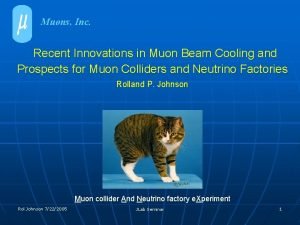Ultrahigh energy upward going muons in SuperKamiokande II

- Slides: 1

Ultra-high energy upward going muons in Super-Kamiokande II Ariana S. Minot (Duke University) Ultra-high energy upward-going muons (E>1 Te. V) are created by the interactions of very high energy neutrinos inside the Earth. They could be produced by astrophysical sources (AGN, etc. ). Improvements to the track fitters were made to reduce backgrounds. Reconstructing muons tracks: OD fit Superk-Kamiokande II Super-Kamiokande is a large water Cherenkov detector located in Kamioka In the Japanese Alps. It is famous for its discovery of neutrino oscillations in 1998. It is a 50 kton cylinder filled with ultra-pure water. There are 2 optically separated regions : the Inner Detector (ID) contains over 11000 photo-multiplier tubes (PMTs) the Outer-Detectpr (OD), a 2 m-thick region surrounding the ID, contains 1885 smaller PMTs. Its’ purpose is to tag entering and exiting particles. After an accident destroyed most of the ID in 2001, Super-Kamiokande was partially rebuilt with half the tubes. This phase is known as SK-II. OD fit performs a linear fit using only hit tubes in the OD. A linear fit to the charge-times distribution is performed: x(t) = x 0 + vx t y(t) = y 0 + vy t z(t) = z 0 + vz t The slope of the best line is an estimate of -cos( ) where is the zenith angle of the fitted muon. Results for SK-II Ultra-high energy upward going muon selection cuts : Total charge > 866000 photo electrons Difference between Entry and Exit times > -40 ns More than 10 hits around entry and exit points Fitted track length > 7 m Fitted -cos( ) <-. 1 Efficiency of cuts on mono-energetic isotropic Monte-Carlo : Super-Kamiokande is exposed to a large flux of downward going muons ---> We must eliminate this background to find the upward going muons. Improvements to OD fit Super Kamiokande Tokyo OD fit can be confused by large isolated charges and can mis-identify proper upward-going events. Why search for ultra-high energy upmu’s ? Ultra high energy upward going muons are produced by very high energy neutrino interactions �i n the rock below the detector. Such neutrinos can be atmospheric neutrinos, but at these high energies, there will be very few. More importantly, high energy neutrinos are thought to come from astrophysical sources such as active galactic nuclei and gamma ray bursts. We searched for such neutrinos in our data, using SK as a telescope for exotic astrophysical objects. Water Cherenkov Imaging method Actual track OD fit mistake Improvement: check that there at least two neighboring hits within 3 m and 50 ns of every hit, to remove outliers. The direction fit is improved by a factor of 2. When charged particles travel in the water at velocity higher than the speed of light in water ( c/n ), an electromagnetic shockwave is produced. This phenomenon (similar to a sonic boom for sound waves) is known as the Cherenkov effect. The photons are emitted around the direction of the track, making a cone with opening angle cos( ) = 1/ n. Selection cuts are applied on SK-II data and SK-II atmospheric neutrino simulation. Upward going muons from the high-energy tail of the atmospheric neutrinos are the main background for this search for astrophysical neutrinos. After selection the events are eye-scanned: Data Horiz Stopp Down Up Multi Junk -ontal -ing Going Muon 3 2 17 1 10 2 MC: 0 Upmu Rck MC: 2 All Wtr 0 0 9 0 0 10 1 19 0 0 We find one candidate in the data: These photons are detected by the PMTs on the wall : the cones intersect with the walls of Super-K, making ring patterns However, when particles of ultra-high energies enter the detector, all the PMTs of the ID are saturated, because the amount of light is enormous. Angle between true and fitted direction In order to search for muons that enter and leave the detector, it is better to use the information provided by the OD. The XXII International Conference on Neutrino Physics and Astrophysics in Santa Fe, New Mexico, June 13 -19, 2006

